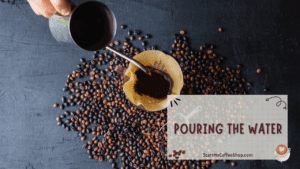Coffee brewed in a French press is highly regarded for its intense, robust taste as well as its full-bodied consistency. It takes careful attention to every step of the brewing process to create the ideal cup of coffee, from choosing beans of high quality to perfecting the brewing method.
To make French press coffee, you should grind fresh coffee beans to a coarse consistency. Add coffee grounds to a French press, pour hot water over them, and let steep for 4 minutes. Press the plunger slowly, then pour and enjoy.
In this article, we will examine the step-by-step procedure for preparing a flavorful and aromatic cup of French press coffee.
Choose the Right Beans

The selection of superior coffee beans is essential for making a delicious cup of French press coffee. The selection of beans with the qualities needed to shine in the French press brewing process is the cornerstone of an amazing coffee experience.
Because whole beans can keep their freshness for a longer period than pre-ground coffee, they are strongly advised over pre-ground coffee. You can guarantee that your cup will have the most taste and aroma by grinding the beans immediately before brewing. Shoppers should look for recently roasted coffee beans while buying coffee. Compared to beans that have been sitting on the shelf for a while, freshly roasted beans give a more vibrant and strong flavor.
Search for beans that are expressly designated as being good for French press brewing. These beans have been chosen with care and roasted to enhance the special features of the French press technique. Although there are many different kinds of coffee beans, Arabica beans are typically regarded as the best option for French press coffee. Their varied flavors, which can be everything from fruity and floral to nutty and chocolatey, are highly regarded. Arabica beans are favored by coffee connoisseurs because they often produce a cup of coffee that is smoother and more refined.
Read more about: Strategic Business Plan for Coffee Shop: A Caffeinated Strategy
Grinding the Beans
The process of grinding the coffee beans right before brewing is crucial for maintaining the flavor and aroma that are trapped within the beans. To achieve optimal extraction and avoid bitterness in the final brew when using a French press, the grind size is crucial.
It is highly advised to use a coarse grind for French press brewing. A well-rounded and flavorful cup of coffee is produced thanks to the slower extraction process made possible by the coarse grind’s bigger particle size. This is because of the water’s longer interaction with the coffee grinds, which allows it to extract the desired tastes without over-extracting bitter components.
To obtain a regular and uniform grind size, an investment in a burr grinder is essential. Burr grinders guarantee that the coffee beans are ground to a consistent coarseness, as opposed to blade grinders, which might produce inconsistent particle sizes. For even extraction and a well-balanced flavor profile in your French press coffee, this consistency is essential.
It’s critical to customize the grind size for French press coffee based on your personal preferences. If the coffee feels under-extracted or weak, you can try slightly finer grinding it. On the other hand, coarsening the grind size can assist resolve problems if the coffee tastes overly strong or extracted.
Preparing the French Press
Keeping your French press clean is essential to obtaining a pure and unadulterated coffee flavor with each brew. It is crucial to carefully clean the French press before each usage to get rid of any leftover tastes or oils from earlier batches. You’ll be able to make consistently great cups of coffee if you take the time to clean them properly.
Remove the plunger and filter assembly from the French press to start the disassembly process. Make sure all coffee grounds and residue are entirely gone before rinsing each component in warm water. You can gently scrape the components with a non-abrasive brush and mild dish soap for a thorough clean. To ensure that there is no soapy residue left, rinse again well.
It is advantageous to warm up the French press before brewing to support maintaining the ideal temperature throughout the brewing process. First, fill the empty French press with hot water and rinse it. This process helps to warm up the French press’s glass or metal body, keeping the coffee hot for longer.
It’s a smart idea to pre-heat your coffee mugs as well. Your newly made coffee will stay hot when poured if you simply pour boiling water into the mugs and let them sit for a minute or two.
The water temperature is crucial for producing a cup of French press coffee that is delicious and well-extracted. It is advised to warm up new, filtered water to about 200°F (93°C). Without scorching or over-extracting the grounds, this temperature enables the best flavor extraction from the coffee.
Measuring and Adding Coffee
Brewing great French press coffee requires achieving the ideal coffee-to-water ratio. The suggested ratio is 1 gram of coffee to every 15 milliliters of water, or 1:15. A balanced extraction is made possible by this ratio, which also guarantees a strong, rich cup of coffee.
Start by calculating the quantity of coffee needed based on the number of cups you plan to brew. About 4 ounces, or 120 milliliters, make up a typical French press cup. You would use around 480 milliliters of water and 32 grams of coffee, for instance, to make four cups (4 cups x 120 milliliters = 480 milliliters; 480 milliliters / 15 = 32 grams).
The time has come to grind the coffee beans to a coarse consistency after determining the appropriate quantity. The uniform grind size provided by a burr grinder enables even extraction and superior flavor. For the French press method, the coarse grind is essential because it stops tiny particles from passing through the filter and producing a gritty cup.
Coffee beans should be ground and then added to the French press carafe. Make sure the plunger is in the up position so that there is room for the water and coffee grinds. To smooth out the grounds, lightly tap the French press on a flat surface.
It’s time to add hot water after the coffee grounds have been added. Don’t forget to pour water that has been heated to the suggested level of 200°F (93°C). Start by adding a little water to evenly moisten the grounds. Allow the coffee to bloom for a short while so that the gases may be released and the flavors can be improved.
Using a circular motion to ensure even saturation, carefully pour the remaining water over the coffee grounds after it has blossomed. To prevent any potential overflow during the brewing process, be careful not to overfill the French press.
Pouring the Water

An important step that needs care and attention to detail is adding hot water to the coffee grinds in the French press. Following the right procedures will result in optimal extraction and, in turn, a cup of coffee that is tasty and well-balanced.
Pouring the water correctly requires calm, steady motion. Pouring gradually improves control and guarantees that all of the coffee grounds are completely wet. Ensuring that every particle comes into touch with the water, makes it easier to extract flavors consistently.
It’s advantageous to pour in a circular motion to encourage equal extraction. Through constant soaking and extraction of the coffee grounds, this motion helps distribute the water uniformly across the coffee bed. You can prevent any areas from being left dry or with insufficient extraction by pouring in a circular pattern.
It’s important to pour carefully and not fill the French press to the brim. It is vital to leave some room at the top of the carafe so that the plunger can fit there when the brewing procedure is finished. Overfilling can result in overflow, a mess, and sometimes even a change in the coffee’s flavor.
Read more about: SWOT Analysis Coffee Shop Business Plan: A Taste of Strategy
Steeping and Blooming
It’s important to give the coffee in the French press the right length of time to steep after adding hot water to the coffee grounds. The flavors can fully develop while steeping, producing a cup of coffee that is well-extracted and powerful. The standard steeping period for French press brewing is about 4 minutes, however, you can change this time based on your preferences.
“Blooming”—a remarkable occurrence that occurs throughout the steeping process—occurs. A captivating scene is produced when the coffee grinds’ contained gases are freed. The coffee’s flavor and aroma are improved by the blooming process. Volatile substances that contribute to the overall flavor character of the brew are carried by the gases as they depart. This results in a cup of coffee that is more flavorful and aromatic.
It’s vital to hold back the impulse to dip the coffee as it steeps. During this time, the plunger should be placed on top of the French press to help preserve heat and stop the coffee from chilling too quickly. However, wait until the steeping time has passed before plunging.
You give the water enough time to get the proper flavors from the coffee grinds by letting the coffee steep for around 4 minutes. This period aids in striking a balance between under- and over-extraction, producing a cup of coffee that is well-rounded. As the aroma and flavors deepen, seeing the blooming process adds a layer of curiosity and pleasure to the brewing process.
Pressing and Pouring
It’s time to gently press the plunger down in the French press to separate the coffee grinds from the liquid after the steeping procedure is finished. For a cup of coffee that is clear and free of sediment, this step is essential.
Start by gently pushing the plunger down while maintaining pressure. The mixture should be stirred just enough to separate the coffee grounds from the brewed coffee. Agitation may result in over-extraction and a cup that tastes possibly harsh.
Slowly depressing the plunger causes the brewed coffee to stay on top of the French press while the coffee grinds settle at the bottom. By keeping the flavors separate, it is easier to retain the intended flavor profile and avoid any undesirable flavors that might develop from extended contact with the grounds.
Pour the newly brewed coffee into warmed mugs when the plunger in the French press hits the bottom, signifying that the coffee grounds have completely separated. You may completely appreciate the flavors and smells of the coffee by preheating the mugs, which helps maintain the coffee’s ideal temperature.
Take care when pouring to prevent upsetting the settling coffee grinds at the bottom of the French press. The brewed coffee is transferred into the mugs with more ease and cleanliness when the pour is gradual and steady.
It’s time to enjoy the results of your labors of brewing now that the coffee has been effectively transported. French press coffee that is delicious, aromatic, and devoid of bitterness should be the result.
Frequently Asked Questions

What size of a grind should I use for French press coffee?
A coarse grind is suggested for French press coffee. By doing this, you can guarantee thorough extraction and avoid having extremely bitter coffee. A rich and full-bodied brew is produced as a result of the coarse grind, which allows the water to pass through the coffee grounds.
How long should I let my French press coffee steep?
For French press coffee, a 4-minute steeping period is advised. This amount of time ensures a balanced extraction and allows the flavors to fully develop. To make a stronger or milder cup of coffee, you can, however, significantly alter the steeping time.
Can I make French press coffee with pre-ground coffee?
To preserve freshness and flavor, it’s best to grind the coffee beans right before brewing, but pre-ground coffee can still be used for French press brewing. Make certain to select a coarse grind that is designated for the French press. But be aware that pre-ground coffee could not taste as flavorful or be as fresh as freshly ground beans.
To learn more on how to start your own coffee shop, check out my startup documents here.
Disclaimer: The information provided by StartMyCoffeeShop.com (“The Site”) is for general informational purposes only. All information on the Site is provided in good faith. However, we make no representation or warranty of any kind, express or implied, regarding the accuracy, adequacy, validity, reliability, availability, or completeness of any information on the Site. Under no circumstance shall we have any liability to you for any loss or damage of any kind incurred as a result of the use of the Site or Reliance on any information provided on the Site. Your use of the Site and reliance on any information on the Site is solely at your own risk. This blog post is for educational purposes only and does not constitute legal advice. Please consult a legal expert to address your specific needs. Terms and Conditions. (https://startmycoffeeshop.com/terms-and-conditions/)

Hi! I’m Shawn Chun
My adventure in coffee began when I first launched my first coffee shop back in the early 2000s. I had to figure out so many things on my own and to make it worse within 2 years of opening two large corporate coffee chains moved in just blocks away from me!
As I saw smaller and even some larger coffee shops in the neighborhood slowly lose customers to these giant coffee chains and slowly close up shop, I knew that I had to start getting creative…or go out of business.
I (like you may be) knew the coffee industry well. I could make the best latte art around and the foam on my caps was the fluffiest you have ever seen. I even had the best state-of-the-art 2 group digital Nuova Simonelli machine money could buy. But I knew that these things alone would not be enough to lure customers away from the name brand established coffee shops.
Eventually, through lots of trial and error as well as perseverance and creativity I did find a way to not only survive but also thrive in the coffee/espresso industry even while those corporate coffee chains stayed put. During those years I learned to adapt and always faced new challenges. It was not always easy, however, in the end, I was the sole survivor independent coffee shop within a 10-mile radius of my location. Just two corporate coffee chains and I were left after that year. All told the corporate coffee chains took down over 15 small independent coffee shops and kiosks and I was the last one standing and thriving.
Along the years I meet others with the same passion for coffee and I quickly learned that it is not only “how good a barista is” that makes a coffee shop successful, but the business side of coffee as well.
Hence why I started this website you are on now. To provide the tools and resources for up and coming coffee shop owners to gain that vital insight and knowledge on how to start a coffee shop successfully.
Stick around, browse through my helpful blog and resources and enjoy your stay! With lots of LATTE LOVE!
Shawn







